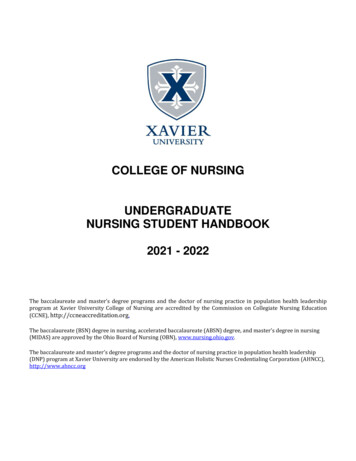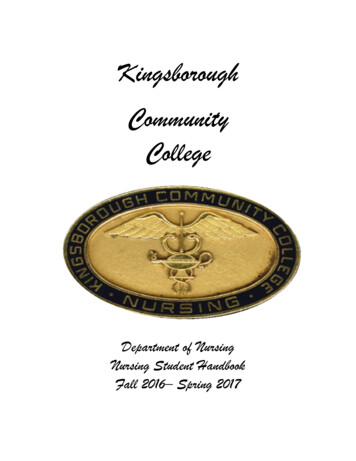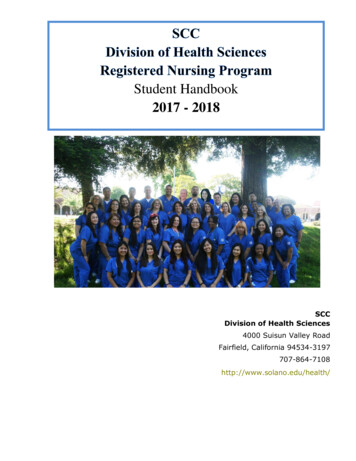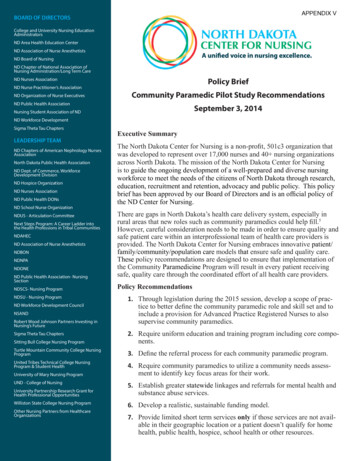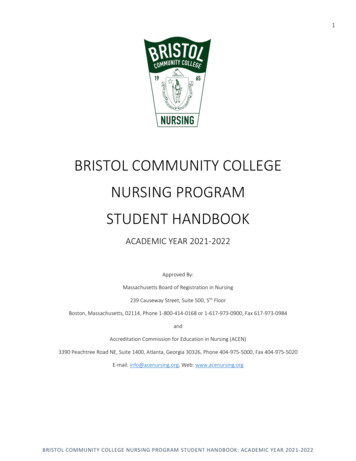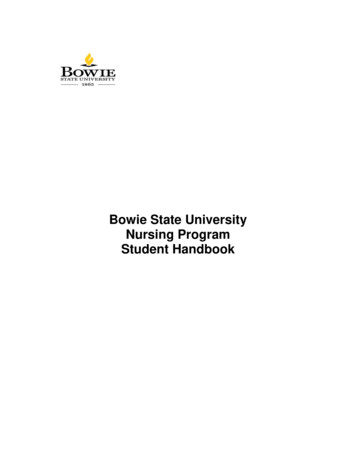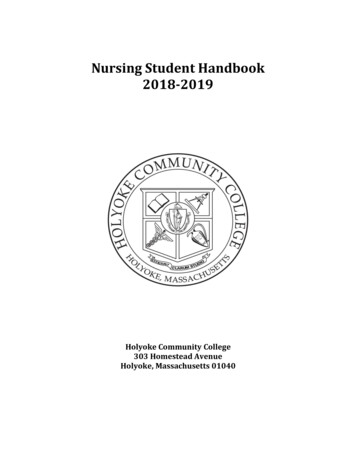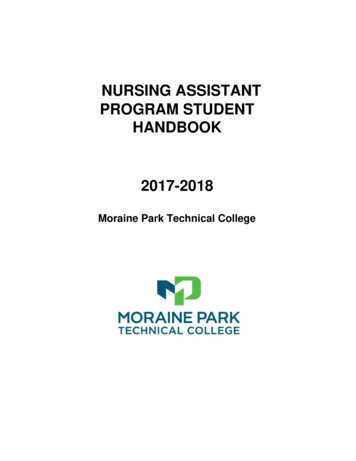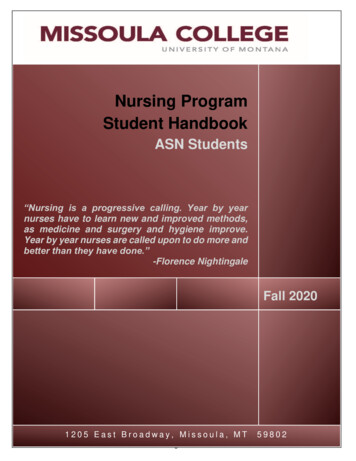
Transcription
Nursing ProgramStudent HandbookASN Students“Nursing is a progressive calling. Year by yearnurses have to learn new and improved methods,as medicine and surgery and hygiene improve.Year by year nurses are called upon to do more andbetter than they have done.”-Florence NightingaleFall 20201205 East Broadway, Missoula, MTGraduaNursing Program Student HandbookFall Semester 2020Page i59802
Table of ContentsIntroduction and Welcome from the Director .1Section 1 – Program .2General Description .2Definitions of Nursing as Defined by Montana State Law .2Curriculum Goals for Associate Degree Registered Nurse Programs .2Academic Calendar .3Nursing Faculty and Staff .4Spring 2020 Contact Information .4Faculty Office Hours .5Mission Statements .5Student Bill of Rights .7Bill of Rights and Responsibilities for Students of Nursing .7Family Education Rights and Privacy Act (FERPA) .8What is FERPA?.8Who is protected under FERPA?.8Student Policies and Procedures .8ANA Code of Ethics for Nurses .10The Code of Ethics for Nurses serves the following purposes: .10Provisions .10Use of Social Media.11Tips to Avoid Social Media Problems .11Guide to the Use of Social Media .12Section 2 – Admission Policies .20Admission Policy and Requirements .20ASN 4-Semester Option .20Scope and Sequence of Nursing Program Curriculum .22ASN Program Course Descriptions .22Withdrawals / Audits / Refunds from Nursing Programs .26Transfer Policy .26Readmission .26Office of Financial Aid .26FAFSA Application Process .26Nursing Program Student Ambassadors .27Nursing Program Student HandbookFall Semester 2020Page ii
Section 3 – Curriculum .28Nursing Program Mission .28Nursing Program Philosophy.28Nursing Practice .28Core Values .29Contributing Concepts .30Statement on Nursing Education.30Regulation and Accreditation .31Program Outcomes .32Student Learning Outcomes .34Nursing Required Testing .34Assessment Technology Incorporated (ATI) Examinations .34What is ATI? .34Modular Study: .35Tutorials: .35Assessments: .35Active Learning/Remediation: .35Kaplan Nursing.35What is Kaplan Nursing and iHuman Patient? .35Integrated Testing:.36Focused Review Tests: .36Proctored Exams: .36Clinical Resources: .36NCLEX Prep: .36Kaplan iHuman Patients: .36Dosage Calculations Policy .36NRSG 234/235 and NRSG 244/245 and NRSG 259/261: .36NRSG 246/247 (Health & Illness of Child & Family Nursing): .37Nursing Course Examinations, In-class and Moodle .37Moodle Tech Support .38Guidelines for Taking Tests in Moodle .38Due Process .39Preceptors .39Clinical and/or Preceptor Sites (may include others) .40Preclinical Entry Requirements .40Essential Clinical Requirements .41Employment During School .41Expected Clinical and Lab Behavior .41Professional Liability .42Supervision During Clinicals .42Travel to Clinical Training Sites .42Nursing Program Student HandbookFall Semester 2020Page iii
Pre and Post Clinical Conferences .42Pre-Clinical Conferences .42Post-Clinical Conferences .42Clinical Attendance .43Clinical Site Parking.43Providence Saint Patrick Hospital:.43Community Medical Center: .43Mandatory Orientation for Clinical .43Student Checklist and Clinical Orientation Manual .44Student Clinical Role .44Library Resources.47UM and Missoula College Libraries .47Providence Saint Patrick Hospital / Providence Health & Services .48Section 4 – Student Policies and Progression .49Address, Phone Number, and Email Changes .49Student and Faculty Communication .49Professional Behavior .49Professional Behavior Rubric .50Uniform Policy .51Progression in Nursing Programs .53Student Conduct Code – Regulations / Plagiarism / Cheating.53Plagiarism .54APA Format and Citation .54Cheating .54Progression Requirements in Lecture/Clinical Courses .54Clinical Evaluation .55Dismissal from Nursing Programs .55Military Deployment .55Progressive Disciplinary Policy .56Appeals .56Graduation .56Employment Opportunities .57Student Background Checks .58Nursing Program Student HandbookFall Semester 2020Page iv
Section 5 – Disability and Health Services .59Disability Services .59DSSS Locations .59Statement of Law for Disability .60Sensory Perception Requirements.60Health Services and Policy .62Health / Liability Coverage .62Healthcare Services .62Helpful Phone Numbers .63Required Immunizations and Documentation .64Pregnancy Policy .65Communicable Disease / Infection Control Policy .65Policy of Reporting of Occupational Exposure to Bloodborne Pathogens .66Section 6 – Appendix and Student Forms .69Required Documentation .69Basic Life Support .69Background Check / Sex Offender Search .69Immunizations .70Additional Forms to Print, Sign & Submit to Administrative Associate: .71Form 1 –Latex Sensitivity Statement .72Form 2 –Student Agreement .73Form 3 – Confidentiality Agreement .74Form 4 – Social Media Quiz .752020/21 Declination: Seasonal Influenza Vaccination Statement .76Hepatitis B Vaccination Request .77Providence St. Patrick Hospital Hepatitis B Vaccine Accept/Decline .78Missoula College UM Occurrence Report .79Missoula College UM Occurrence Report Follow-up .81Missoula College Nursing Student Remediation Process .82Nursing Program Student HandbookFall Semester 2020Page v
Introduction and Welcome from the DirectorWelcome to Missoula College University of Montana (MC), Nursing Program. We are very excitedyou are here for the Associate of Science in Nursing Program (ASN). Nursing is both an art anda science, and the faculty take great pride in the nursing education we provide to our students.We also take great pride in our culture that embraces students and our role as educators and thefacilitators of education. You are the future of nursing and we want you to provide you with theappropriate didactic theory, critical thinking and hands-on skills required to find entry-levelpositions as nurses in healthcare locally, nationally, and globally.Teamwork has also become a major focus in healthcare. Nurses collaborate with other membersof the healthcare team to encourage individuals to participate in their care. Using the Institute ofMedicine report entitled, “To Err Is Human: Building a Safer Health System” and QSENCompetencies, we hope to instill in our graduates the understanding and practice of teamworkand collaboration essentials needed to provide safe and effective nursing care in meeting today’scontemporary health care challenges (Baldwin, 1994; Grant et al., 1995; Tresolini et al., 1995).Team work begins with you and the development of a collaborative, civil, and caring team withyour classmates and faculty.The Missoula College Associate of Science Degree in the Nursing Program began in 2006. Asyou know, nursing is constantly evolving and our nursing programs must evolve to stay current.With changes to the Montana ASN curriculum which began in the fall of 2016, Missoula Collegewent forward with a two-year straight through registered nursing program. Before that time,students would have to take a one-year PN program and either step out to practice as an LPN, orreapply to the RN program. We called this the 1 1 program. In December of 2016 we phased outour PN program, which had begun in 1964.This handbook has been carefully compiled to assist you in settling into your role as a student asquickly as possible so that you are able to make the most of your learning experience in our ASNprogram. It has been created with two objectives: To provide clear and thorough guidelines and to serve as a practical, helpful resourceduring your student experience at Missoula College. The information that you will find inthese pages is updated each semester to promote accuracy of information for student useand guidance. To inform students of the rules and regulations of classroom, lab, clinical and professionalexpectations.In the event a change is made to this handbook, notification will be placed on the MC website andMoodle. Student ambassadors will also be notified and announcements will be posted on thestudent information bulletin board located in the Nursing Lab (MC116). This handbook is alsoavailable on the MC website electronically.On behalf of the staff at Missoula College, we welcome you and hope that your education at thecollege is both challenging and rewarding.Linda Barnes MSN, RN-BCNursing Program DirectorMissoula College of University of MontanaNursing Program Student HandbookFall Semester 2020Page 1
Section 1 – ProgramGeneral DescriptionThe Associate of Science Nursing Program (ASN) at Missoula College is designed for studentsto progress to care of the more complex patient with less predictable outcomes. An Associate ofScience RN assesses clients, formulates nursing diagnoses, and plans, implements andevaluates nursing care provided in structured healthcare settings. The ASN practices within theethical, legal and regulatory frameworks of nursing to provide care to individuals, groups, andfamilies. The Associate of Science Nurse works together with other members of the healthcareteam to manage the human, physical, financial, and technical needs of the client.A Licensed Practical Nurse (your license must be current and unencumbered), may apply to theASN program when they have taken all general education courses listed in the MC program. Ifthe LPN graduated from a program other than Missoula College, they must have their transcriptevaluated for course equivalency by the registrar. The ASN program may be completed in foursemesters, once general education credits have been evaluated and confirmed completed.However we encourage you to take all co-requisite courses before beginning your nursingcourses.The ASN program is approved through and by the Montana State Board of Nursing, and isaccredited by the Accreditation Commission for Education in Nursing (ACEN).Definitions of Nursing as Defined by Montana State LawMont. Code Ann. § 37-8-102 (9) "Practice of professional nursing" means the performance ofservices requiring substantial specialized knowledge of the biological, physical, behavioral,psychological, and sociological sciences and of nursing theory as a basis for the nursing process.The nursing process is the assessment, nursing analysis, planning, nursing intervention, andevaluation in the promotion and maintenance of health, the prevention, case finding, andmanagement of illness, injury, or infirmity, and the restoration of optimum function. The term alsoincludes administration, teaching, counseling, supervision, delegation, and evaluation of nursingpractice and the administration of medications and treatments prescribed by physicians,naturopathic physicians, physician assistants, optometrists, advanced practice registered nurses,dentists, osteopaths, or podiatrists authorized by state law to prescribe medications andtreatments. Each registered nurse is directly accountable and responsible to the consumer for thequality of nursing care rendered. As used in this subsection (9);(a) "nursing analysis" is the identification of those client problems for which nursing care isindicated and may include referral to medical or community resources;(b) "nursing intervention" is the implementation of a plan of nursing care necessary to accomplishdefined goals.Curriculum Goals for Associate Degree Registered Nurse ProgramsThe Associate Degree graduate shall assess, formulate a nursing diagnosis, plan, implement,and evaluate nursing care provided in structured health care settings. The graduate will practicewithin the ethical, legal, and regulatory frameworks of nursing and provide care to individuals,groups, and families while utilizing a knowledge base from the natural and social sciences andhumanities. The associate degree nurse works together with other members of the health careteam to manage the human, physical, financial, and technical needs of the client.Nursing Program Student HandbookFall Semester 2020Page 2
Academic CalendarFall 2020August 14 . New Nursing Student OrientationAugust 19 . Fall Semester Classes BeginSeptember 7 . Labor Day – No Classes, Offices ClosedNovember 3 . Election Day – No Classes, Offices ClosedNovember 11 . Veterans Day Observed – No Classes, Offices ClosedNovember 23-25 . Final ExamsNursing Program Student HandbookFall Semester 2020Page 3
Nursing Faculty and StaffFall 2020 Contact InformationNursing Program Faculty:Nursing Administration Office:Wendy Barker MSN, RNCAssistant ProfessorOffice: MC 304 / Office Phone: 406-243-7827Office Email: wendy.barker@umontana.eduLinda Barnes MSN, RN-BCNursing Program Director, Associate ProfessorOffice: MC 306 / Office Phone: 406-243-7875Work Email: linda.barnes@umontana.eduDiana Jenkins MSN, RNAdjunct FacultyOffice: MC 303 / Office Phone: noneOffice Email: diana.jenkins@mso.umt.eduRobin MacMillanNursing Lab SupervisorOffice: MC 116 / Office Phone: 406-243-7855Office Email: robin1.macmillan@umontana.eduAnn McCloud Sneath APRN, MSNAdjunct FacultyOffice: MC 309 / Office Phone: noneOffice Email: ann.mcloudsneath@mso.umt.eduCyndi StaryAdministrative AssociateOffice: MC 441 / Office Phone: 406-243-7846Office Email: cyndi.stary@umontana.eduShannon Scally MHA, MSN, RNAdjunct FacultyOffice: MC 302 / Office Phone: 243-7872Office Email: shannon.scally@umontana.eduGinger Sillars MSN, RNAssistant ProfessorOffice: MC 305 / Office Phone: 406-243-7863Office Email: ginger.sillars@umontana.eduNursing Program Student HandbookFall Semester 2020Health Professions ChairpersonDan Funsch MS, RT(R)Assistant Professor, Radiologic TechnologyOffice: MC 420 / Cell Phone: 406-243-7851Office Email: dan.funsch@umontana.eduPage 4
Faculty Office HoursFaculty office hours are posted on course syllabi, faculty office doors, and the bulletin boardlocated in the Nursing Lab (MC116), as well as at the Nursing Student Resources -resources.php).Mission StatementsMission Statement for University of Montana - MissoulaThe University of Montana--Missoula pursues academic excellence as demonstrated by thequality of curriculum and instruction, student performance, and faculty professionalaccomplishments. The University accomplishes this mission, in part, by providing uniqueeducational experiences through the integration of the liberal arts, graduate study, andprofessional training with international and interdisciplinary emphases. The University alsoeducates competent and humane professionals and informed, ethical, and engaged citizens oflocal and global communities; and provides basic and applied research, technology transfer,cultural outreach, and service benefiting the local community, region, state, nation and the world.The University pursues fulfillment of their mission through five Core Themes that drive everyaspect of its mission and vision:1. Partnering for Student Success - The University will help its students succeed academicallyand personally so they graduate well-prepared for their careers or further education.2. Education for the Global Century – UM will offer an educational experience at all degreelevels that provides graduates the foundation to make positive impacts on a world that isincreasingly interconnected.3. Discovery and Creativity to Serve Montana and the World – The University will transformdiscovery and creativity into knowledge, applications and experiences in ways that benefitthe state, region, nation and world.4. Dynamic Learning Environment – UM will enhance its character as a place where peopleare passionate about learning, discovery and growth.5. Planning-Assessment Continuum – The University will model transparency, systematiccommunication and sound decision-making to ensure that resources are marshaled toachieve UM’s mission.Missoula College of University of Montana Mission StatementThe Mission of Missoula College is to create a comprehensive, accessible, student-centeredlearning environment that fosters individual growth, facilitates workforce development, andprovides a foundation for advanced academic achievement.Missoula College pursues fulfillment of their mission by: Creating a student-centered environment; Providing college level technical and general education learning opportunities; Facilitating development of oral and written communication skills, thus providing afoundation for advanced academic skills; Fostering individual growth through development of critical thinking and problem-solvingskills;Nursing Program Student HandbookFall Semester 2020Page 5
Providing the regional workforce with credentialed, skilled, and competent entry-leveltechnicians;Responsive to emerging workforce needs;Supporting the development of ethical behavior;Encouraging students to become responsible members of a global and multiculturalsociety;Facilitating and promoting lifelong learning.Missoula College of University of Montana Health Professions MissionStatementThe Health Professions Department of the University of Montana seeks to prepare students to behealth practitioners who are technically competent and who are effective in a variety of clinical,agency and community settings. The Health Professions Department offers four Associate ofApplied Science (A.A.S.) Degrees, one Associate of Science (A.S.) Degree, and one certificateprogram with courses and learning experiences that contribute to understanding the health needsof individuals and society. Clinical affiliations and on-site experiences are essential elements ofall programs; local communities, their agencies, and organizations are a valuable resource andprovide cooperative learning experiences in health delivery systems.Missoula College Heal
Nursing Program Student Handbook Fall Semester 2020 Page i Gradua Fall 2020 Nursing Program Student Handbook ASN Students "Nursing is a progressive calling. Year by year nurses have to learn new and improved methods, as medicine and surgery and hygiene improve. Year by year nurses are called upon to do more and .
